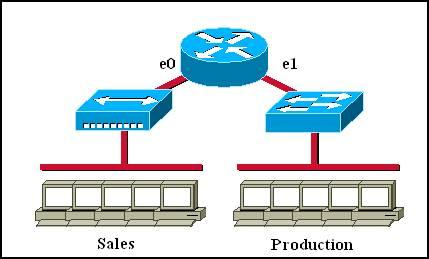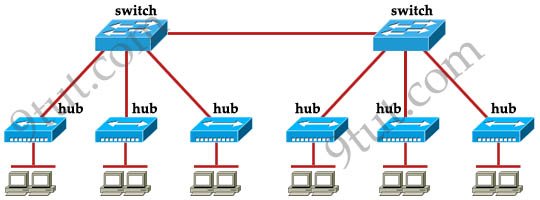Here you will find answers to Basic Questions – Part 2
A. Filtering can occur based on Layer 3 information.
B. Broadcasts are eliminated.
C. Routers generally cost less than switches.
D. Broadcasts are not forwarded across the router.
E. Adding a router to the network decreases latency.
Answer: A D
 A. There are two broadcast domains in the network.
A. There are two broadcast domains in the network.
B. There are four broadcast domains in the network.
C. There are six broadcast domains in the network.
D. There are four collision domains in the network.
E. There are five collision domains in the network.
F. There are seven collision domains in the network.
Answer: A F
Both router and switch can break up collision domains so there is only 1 collision domain on the left of the router (because hub doesn’t break up collision domain) and there are 6 collision domains on the right of the router (1 collision domain from e1 interface to the switch + 5 collision domains for 5 PCs in Production) -> F is correct.
 A. Ensure that the Ethernet encapsulations match on the interconnected router and switch ports.
A. Ensure that the Ethernet encapsulations match on the interconnected router and switch ports.
B. Ensure that cables A and B are straight-through cables.
C. Ensure cable A is plugged into a trunk port.
D. Ensure the switch has power.
E. Reboot all of the devices.
F. Reseat all cables.
Answer: B D F
A. to uniquely identify devices at Layer 2
B. to allow communication with devices on a different network
C. to differentiate a Layer 2 frame from a Layer 3 packet
D. to establish a priority system to determine which device gets to transmit first
E. to allow communication between different devices on the same network
F. to allow detection of a remote device when its physical address is unknown
Answer: A E
MAC addresses are only used to communicate on the same network. To communicate on different network we have to use Layer 3 addresses (IP addresses) -> B is not correct; E is correct.
Layer 2 frame and Layer 3 packet can be recognized via headers. Layer 3 packet also contains physical address -> C is not correct.
On Ethernet, each frame has the same priority to transmit by default -> D is not correct.
All devices need a physical address to identify itself. If not, they can not communicate -> F is not correct.

A. UTP cable
B. STP cable
C. Coaxial cable
D. Fiber optic cable
Answer: D
A. tracert address
B. ping address
C. arp address
D. traceroute address
Answer: A
Note: “traceroute” command has the same function of the “tracert” command but it is used on Cisco routers only, not on a PC.
 A. wrong DNS server
A. wrong DNS server
B. wrong default gateway
C. incorrect IP address
D. incorrect subnet mask
Answer: C
 A. one
A. one
B. six
C. twelve
D. two
Answer: A
For your information, there are 7 collision domains in this exhibit (6 collision domains between hubs & switches + 1 collision between the two switches).
Host A has tested connectivity to a remote network. What is the default gateway for host A?
A. 172.16.182.1
B. 192.168.1.1
C. 10.16.176.1
D. 192.168.1.6
Answer: A
A. packet switching
B. access layer security
C. path selection
D. VLAN membership assignment
E. bridging between LAN segments
F. microsegmentation of broadcast domains
Answer: A C
Question 1
What are some of the advantages of using a router to segment the network? (Choose two)A. Filtering can occur based on Layer 3 information.
B. Broadcasts are eliminated.
C. Routers generally cost less than switches.
D. Broadcasts are not forwarded across the router.
E. Adding a router to the network decreases latency.
Answer: A D
Question 2
Which of the following statements describe the network shown in the graphic? (Choose two)
B. There are four broadcast domains in the network.
C. There are six broadcast domains in the network.
D. There are four collision domains in the network.
E. There are five collision domains in the network.
F. There are seven collision domains in the network.
Answer: A F
Explanation
Only router can break up broadcast domains so in the exhibit there
are 2 broadcast domains: from e0 interface to the left is a broadcast
domain and from e1 interface to the right is another broadcast domain
-> A is correct.Both router and switch can break up collision domains so there is only 1 collision domain on the left of the router (because hub doesn’t break up collision domain) and there are 6 collision domains on the right of the router (1 collision domain from e1 interface to the switch + 5 collision domains for 5 PCs in Production) -> F is correct.
Question 3
Refer to the exhibit. The two connected ports on the switch are not
turning orange or green. What would be the most effective steps to
troubleshoot this physical layer problem? (Choose three)
B. Ensure that cables A and B are straight-through cables.
C. Ensure cable A is plugged into a trunk port.
D. Ensure the switch has power.
E. Reboot all of the devices.
F. Reseat all cables.
Answer: B D F
Explanation
The ports on the switch are not up indicating it is a layer 1
(physical) problem so we should check cable type, power and how they are
plugged in.
Question 4
For what two purposes does the Ethernet protocol use physical addresses? (Choose two)A. to uniquely identify devices at Layer 2
B. to allow communication with devices on a different network
C. to differentiate a Layer 2 frame from a Layer 3 packet
D. to establish a priority system to determine which device gets to transmit first
E. to allow communication between different devices on the same network
F. to allow detection of a remote device when its physical address is unknown
Answer: A E
Explanation
Physical addresses or MAC addresses are used to identify devices at layer 2 -> A is correct.MAC addresses are only used to communicate on the same network. To communicate on different network we have to use Layer 3 addresses (IP addresses) -> B is not correct; E is correct.
Layer 2 frame and Layer 3 packet can be recognized via headers. Layer 3 packet also contains physical address -> C is not correct.
On Ethernet, each frame has the same priority to transmit by default -> D is not correct.
All devices need a physical address to identify itself. If not, they can not communicate -> F is not correct.
Question 5
Refer to the exhibit. Two buildings on the San Jose campus of a small
company must be connected to use Ethernet with a bandwidth of at least
100 Mbps. The company is concerned about possible problems from voltage
potential difference between the two buildings. Which media type should
be used for the connection?
A. UTP cable
B. STP cable
C. Coaxial cable
D. Fiber optic cable
Answer: D
Explanation
Because the company has problem about voltage potential difference
between the two buildings so they should connect via fiber optic cable
which uses light pulses to transmit information instead of using
electronic pulses.
Question 6
Which command can be used from a PC to verify the connectivity between host that connect through path?A. tracert address
B. ping address
C. arp address
D. traceroute address
Answer: A
Explanation
To check the connectivity between a host and a destination (through
some networks) we can use both “tracert” and “ping” commands. But the
difference between these 2 commands is the “tracert” command can display
a list of near-side router interfaces in the path between the source
and the destination. Therefore the best answer in this case is A –
tracert address.Note: “traceroute” command has the same function of the “tracert” command but it is used on Cisco routers only, not on a PC.
Question 7
Refer to the exhibit. A network engineer is troubleshooting an
internet connectivity problem on the computer. What causing the problem?
B. wrong default gateway
C. incorrect IP address
D. incorrect subnet mask
Answer: C
Explanation
The IP address of the PC (192.168.11.2/24) is not on the same network with its gateway 192.168.1.1 -> C is correct.
Question 8
How many broadcast domains are shown in the graphic assuming only the default vlan is configured on the switches?
B. six
C. twelve
D. two
Answer: A
Explanation
Only router can break up broadcast domains but in this exhibit no router is used so there is only 1 broadcast domain.For your information, there are 7 collision domains in this exhibit (6 collision domains between hubs & switches + 1 collision between the two switches).
Question 9
Refer to the exhibit.|
PC> tracert 10.16.176.23 Tracing route to 10.16.176.23 over a maximum of 30 hops 1 31 ms 31 ms 32ms 172.16.182.1 2 62 ms 62 ms 62 ms 192.1681.6 3 93 ms 92 ms 34 ms 192.168.1.10 4 125 ms 110ms 125ms 10.16.176.23 Trace complete. |
A. 172.16.182.1
B. 192.168.1.1
C. 10.16.176.1
D. 192.168.1.6
Answer: A
Explanation
It will list all the routers (from nearest to farthest) it passes
through until it reaches its destination so the first hop is its nearest
IP. If we ping from a PC, it is also the default gateway for that PC
-> A is correct.
Question 10
What functions do routers perform in a network? (Choose two)A. packet switching
B. access layer security
C. path selection
D. VLAN membership assignment
E. bridging between LAN segments
F. microsegmentation of broadcast domains
Answer: A C
No comments:
Post a Comment